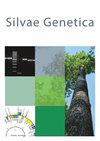Genetic control of silvicultural traits in Balfourodendron riedelianum (ENGL.) ENGL.
IF 1
4区 农林科学
Q3 FORESTRY
引用次数: 6
Abstract
Abstract The Atlantic Forest has very high levels of biodiversity and is considered one of the most important and threatened biomes in the world. Balfourodendron riedelianum is one of the forest’s characteristic tree species that is currently under considered endangered due to timber extraction and forest fragmentation. With the goal of generating information that may contribute to the genetic conservation of B. riedelianum, genetic parameters are estimated for quantitative traits important for silviculture in a provenance and progeny test located in the Experimental Station of Luiz Antônio, São Paulo State, Brazil. The test was established in 1986 and consists of three provenances, from which open-pollinated seeds from 19 seed trees were collected. The following traits were evaluated at 32 years of age: diameter at breast height (DBH), total height (H), stem height (SH), stem straightness (SS), and forking (FOR). The estimates were carried out using the REML/BLUP method. Significant genetic variation among progenies was detected for all traits (except SH) and between provenances for DBH. The coefficient of individual genetic variation (CVgi) ranged from 2.5 to 9.5 %. The mean heritability among progeny ( hf2 $h_f^2$ ) was substantial for DBH (0.44) and FOR (0.36), enabling the selection of families with the highest DBH and lowest FOR for population improvement. Genotypic and phenotypic correlations among traits were also found. We conclude that there is genetic variability in the population that can be exploited in future breeding programs and for the genetic conservation of the species.Balfourodendron riedelanum (ENGL.)造林性状的遗传控制心血管病。
大西洋森林具有非常高的生物多样性,被认为是世界上最重要和最受威胁的生物群落之一。Balfourodendron riedelianum是森林的特色树种之一,由于木材开采和森林破碎化,目前被认为是濒危树种。为了获得可能有助于riedelianum遗传保护的信息,在巴西圣保罗州路易斯Antônio实验站进行的种源和后代试验中,估计了对造林重要的数量性状的遗传参数。该试验于1986年建立,由三个种源组成,从中收集了19棵种子树的开放授粉种子。在32岁时评价以下性状:胸径(DBH)、总高度(H)、茎高(SH)、茎直度(SS)和分枝(FOR)。使用REML/BLUP方法进行估计。子代间(除SH外)和种源间(胸径)均存在显著遗传变异。个体遗传变异系数(CVgi)为2.5% ~ 9.5%。子代平均遗传力(hf2 $h_f^2$)对胸径(0.44)和for(0.36)均有显著影响,有利于选择胸径最高和for最低的家族进行群体改良。性状间也存在基因型和表型相关性。我们得出结论,种群中存在遗传变异,可以在未来的育种计划和物种的遗传保护中加以利用。
本文章由计算机程序翻译,如有差异,请以英文原文为准。
求助全文
约1分钟内获得全文
求助全文
来源期刊

Silvae Genetica
农林科学-林学
CiteScore
2.20
自引率
10.00%
发文量
10
审稿时长
3 months
期刊介绍:
Silvae Genetica is an international peer reviewed journal with more than 65 year tradition and experience in all fields of theoretical and applied Forest Genetics and Tree breeding. It continues "Zeitschrift für Forstgenetik und Forstpflanzenzüchtung" (Journal of Forest Genetics and Forest Tree Breeding) founded by W. LANGNER in 1951.
 求助内容:
求助内容: 应助结果提醒方式:
应助结果提醒方式:


